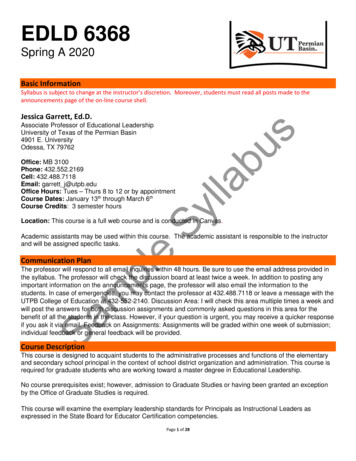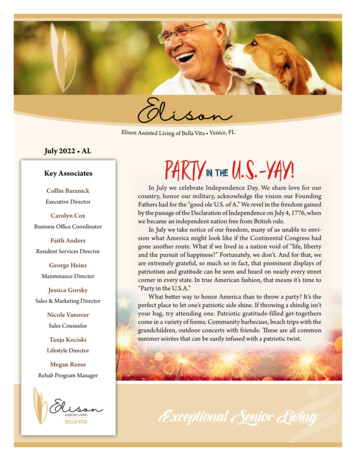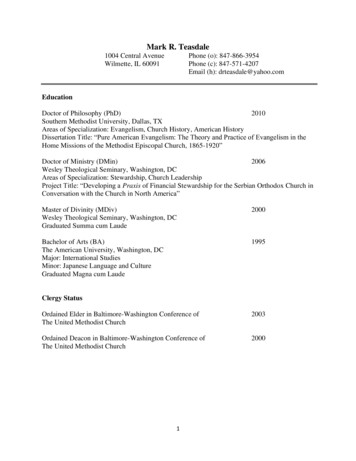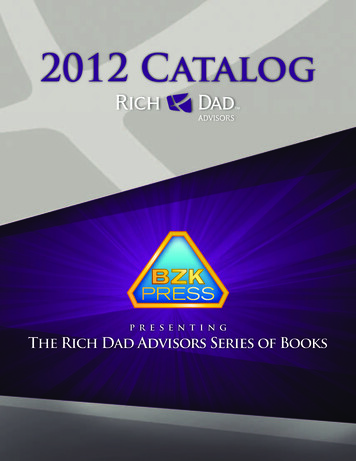
Transcription
EDLD 6368Spring A 2020Basic InformationSyllabus is subject to change at the instructor’s discretion. Moreover, students must read all posts made to theannouncements page of the on-line course shell.Jessica Garrett, Ed.D.llaSyOffice: MB 3100Phone: 432.552.2169Cell: 432.488.7118Email: garrett j@utpb.eduOffice Hours: Tues – Thurs 8 to 12 or by appointmentCourse Dates: January 13th through March 6thCourse Credits: 3 semester hoursbusAssociate Professor of Educational LeadershipUniversity of Texas of the Permian Basin4901 E. UniversityOdessa, TX 79762Location: This course is a full web course and is conducted in Canvas.eAcademic assistants may be used within this course. The academic assistant is responsible to the instructorand will be assigned specific tasks.Communication PlanSamplThe professor will respond to all email inquiries within 48 hours. Be sure to use the email address provided inthe syllabus. The professor will check the discussion board at least twice a week. In addition to posting anyimportant information on the announcements page, the professor will also email the information to thestudents. In case of emergencies, you may contact the professor at 432.488.7118 or leave a message with theUTPB College of Education at 432-552-2140. Discussion Area: I will check this area multiple times a week andwill post the answers for both discussion assignments and commonly asked questions in this area for thebenefit of all the students in the class. However, if your question is urgent, you may receive a quicker responseif you ask it via email. Feedback on Assignments: Assignments will be graded within one week of submission;individual feedback or general feedback will be provided.Course DescriptionThis course is designed to acquaint students to the administrative processes and functions of the elementaryand secondary school principal in the context of school district organization and administration. This course isrequired for graduate students who are working toward a master degree in Educational Leadership.No course prerequisites exist; however, admission to Graduate Studies or having been granted an exceptionby the Office of Graduate Studies is required.This course will examine the exemplary leadership standards for Principals as Instructional Leaders asexpressed in the State Board for Educator Certification competencies.Page 1 of 28
Today’s Principal must demonstrate learner-centered leadership as he or she encourages and nurturesmaximum student performance and helps improve staff productivity and parent participation in educationalsuccess for all. To better acquaint you with the 6 Domains, please visit the following web site:http://www.tx.nesinc.com/TestView.aspx?f HTML FRAG/TX268 PrepMaterials.htmlThe Principal as Instructional Leader Test Framework describes the 6 domains and 11 competencies andsupporting standards for each competency. The course is designed to help prepare Principal Candidates tosuccessfully pass the TExES Principal Exam and model learner-centered leadership in everyday practice asexemplary educators.VisionThe vision of the College of Education is a community of life-long learners who actively reflect on the impact oftheir values, attitudes, beliefs, and practices.SyllabusMissionThe mission of the College of Education is to prepare pre-service and professional educators who areproactive in nurturing the life-long development of all learners. This mission will be accomplished by: Facilitating the acquisition of necessary knowledge, skills, and dispositions; Cultivating the value of diversity Encouraging collaborative inquiry, innovation, and research; Promoting collegiality and service in schools and communities; Integrating technology into practice; Providing opportunities for professional growth; and Influencing educational practices and policies at the local, state, and national level.mpleLearning Outcomes for Principal Candidates and Other School-Based Professionals:The faculty expects that candidates will: Demonstrate content knowledge in their respective content-area Use appropriate processes and teaching practices Apply knowledge about child and adolescent development Incorporate knowledge of diversity in planning and delivering instruction Incorporate technology in planning and delivering instruction Plan for and assess students’ learning Create an appropriate learning environment Communicate and collaborate with all stakeholders Engage in professional growthSaCandidate Proficiencies:To achieve the learning outcomes, candidates must demonstrate that they “are gaining the knowledge, skills,and dispositions necessary to have a positive impact on P-12 student learning” (NCATE, 2006, p. 9). Thefollowing is a list of the specific knowledge, skills, and dispositions that the faculty has determined areimportant for each candidate to possess and exhibitKnowledge (K): Our candidates will exhibit knowledge about and understand the impact on teaching andstudent learning of:1. theoretical perspectives of the profession2. the content, processes, and practices appropriate for their students3. child and adolescent development4. diversity5. technology6. planning and assessment7. the learning environment and classroom management8. collaboration9. legal and ethical issues related to educationPage 2 of 28
busSkills (S): Our candidates will be able to:1. select appropriate content for use in lesson planning and delivery2. apply best practices to promote learning in all students3. use knowledge of child and adolescent development to direct their teaching4. select from an array of techniques to meet the needs of diverse learners5. integrate the use of technology into the learning environment6. use appropriate assessments to measure students’ developmental progress7. develop an appropriate learning environment8. apply classroom management techniques9. communicate with all members of the educational community (students, families, othereducators, administration, community members)10. reflect on their professional performance in order to improve their professional effectiveness11. employ ethical and legal standards in educationllaDispositions (D): Our candidates will demonstrate a/an:1. respect for themselves and a positive regard for others2. passionate nature about learning3. belief in the value of a learner-centered instruction4. dedication to providing a safe and supportive learning environment5. acknowledgement of and respect for the fact people are shaped by their cultures6. commitment to clear and accurate communication7. professional and ethical attitude8. desire to keep current on educational research and practice.Prerequisites: NonemMaterials – RequiredpleSyDiversity Proficiencies (DP):1. Instill the awareness of diversity for implementing inclusive instruction2. Incorporate the diverse nature of learning and teaching as exemplified in the global community.3. Model critical global thinking through coursework4. Conceptualize diversity experiences from a variety of perspectives:a) to strive for social justice, equality, and equity for all learnersb) to continue the process of self-growth, narrowing the student achievement gap in our nationc) to empower all learners as citizens in a global societySaDesravines, J, Aquino, J, Fenton, B. Breakthrough Principals: A Step-by-Step Guide to Building StrongerSchools. San Francisco, CA: Jossey-Bass, 2016.ISBN-13: 978-1118801178ISBN-10: 1118801172Wiggins, G. & McTighe, J. Understanding by Design: Guide to Creating High-quality Units. Alexandra, VA:ASCD, 2011.ISBN 10: 0-13-338830-1ISBN 13: 978-0-13-338830-5Computer Skills and Software Requirements:Student will need to create word processing documents, save files, submit files.Students, Faculty and Staff at UTPB can use cloud versions of MS Office 365 through use of their UTPB emailaddress. For more information refer to: UTPB Office 365 Page.Page 3 of 28
To obtain software licensing and media for selected Microsoft titles at very low cost through a softwareagreement: demic CalendarSpring 2020 – 1st 8 Week Sessionbus Mon, January 13, 2020 Spring 2020 Classes Begin Mon, January 13, 2020 Spring 2020 1st 8 weeks session Classes begin Wed, January 15, 2020 Spring 2020 1st 8 weeks session Last day to add a course Tue, January 21, 2020 Spring 2020 1st 8 weeks session Last day to drop the course without creating a record Wed, January 22, 2020Spring 2020 Last day to add a course Wed, January 29, 2020 Spring 2020 Last day to drop a course without creating an academic record Thu, February 06, 2020 Transfer Thursday Fri, February 14, 2020 Spring 2020 First 8 weeks session Last day to drop or withdraw from this session Thu, March 05, 2020 Transfer Thursday Fri, March 06, 2020 Spring 2020 First 8 weeks session last day of classes or final exam day Mon, March 09, 2020 Spring 2020 Spring Break Mon, March 09, 2020 Spring 2020 Second 8 weeks sessions Class beginsSampleSyllaAcademic CalendarPage 4 of 28
EDLD 6368 PRINCIPALSHIP“Big Ideas”Module 7Principals create a campusculture that sets highexpectations, promoteslearning, and providesintellectual stimulation for self,students, and staff.busModule 1Principals provide avision for improvingstudent success.Module 6Principals must reflect onhis or her practice, seekand act on feedback, andstrive to continuallyimprove, learn, and grow.pleSyllaModule 2Principals engage in selfreflection and analyticaldiagnosis for improvement.SamModule 3Principals must ensure apositive, collaborative, andcollegial school culture thatfacilitates and enhances theimplementation of campusinitiatives and studentachievement.Module 4Principals must assess campusneeds, review a wide set ofevidence to determine thecampus’s priorities, and setambitious and measureablegoals, targets, and strategiesthat form the campus plan.Page 5 of 28Module 5Principals must balancewhat is best for students,their campus, and theirfaculty/staff.
Course ActivitiesDiscussions (7) 20 pts apiece – total – 140 ptsA reflective question or questions will be posted by the Professor each week, based on assigned readings. Studentsshould log into “Discussions Tool” to review these questions and post answers to the discussion question. Students willpost their response, as well as replying to the posts of at least two other students. Discussion posts must be made by thedue date to receive full credit.Assignments (7) – 100 pts apiece – total – 700 ptsbusAfter completing assigned readings, students will review PowerPoint presentations prepared by an instructor. ThePowerPoint lectures will be summaries, elaborations of the textbook material, and/or links to related information on theWeb. After you have completed reviewing the lecture, you should then log into “Assignment Tool” and complete therequired assignment.Student Information Sheet – 10 ptsStudents will fill out and submit the Student Information Sheet available in the Modules tab of the on-line course shell.Module Discussion and Assignment SchedulellaAssigned Readings, Discussion Topics, and Module Assignments Posted in Module Folders of OnlineCourse Shell.SyStudent Information Sheet due by midnight, Wednesday, March 20th.Module 1 – School DevelopmentIntroduction and Chapters 1 and 2 of Breakthrough Principals: A Step-by-Step Guide to Building StrongerSchoolseDates: January 13 - 19plObjectives:Sam1. Candidate will critically analyze school improvement issues on their campus, and prioritize changeefforts needed to produce results.2. Candidate will use the Transformational Leadership Framework (TLF) as a tool to identify and capturedata, artifacts, and strategies relevant to campus improvement.3. Candidate will acclimate to the norms and expectations of the course to insure success in their learningof this content.Video Hook: https://www.youtube.com/watch?v yi-GnOtSJ38The Relentless Principal – Module 1 School DevelopmentModule 1 Discussion Participation Due January 17th by 11:59PM (This deadline is a Friday evening. Allother discussion deadlines will be midnight on Wednesday of a given week.)Effective educational leaders provide a vision for improving student success.Diagnose the most pressing school improvement priorities at your campus, and briefly discuss you haveidentified this as a priority. What promising practices does your school already have in place and which actionswould you prioritize to start making changes?Page 6 of 28
Post your answer to the Module 1 Discussion to this forum by creating a new thread. Also, please reply to atleast 2 of your peer's posts.Module 1 AssignmentTransformational Leadership Framework (TLF), Action Planning, and Data IdentificationUsing Table 2.2 on page 35 of Breakthrough Principals: A Step-by-Step Guide to Building Stronger Schools,create a TLF Analysis of your campus. Be sure to incorporate possible data sources from the Principal’s Tool2.1 on pages 269-270 of the textbook. If you are so inclined, put together a small team of colleagues and videoyourself leading this process.ARTIFACTSEVIDENCETLF STAGE ANDLEVERNEXT STEPS/STRATEGIESbusTLF ACTIONSyllaOperations,master scheduleCulture,behavioralexpectationsLearning andteachingTalentmanagementDue January 19th by 11:59 pm (midnight)eModule 2 – Learning and Teaching and Understanding byDesignplChapters 3 of Breakthrough Principals: A Step-by-Step Guide to Building Stronger SchoolsmEntire Book - Understanding by Design: Guide to Creating High-Quality UnitsSupplemental Material: www.wiley.com/go/newleadersSaDates: January 20 – 26thObjectives:1. Candidate will diagnose the level of rigor that exists in their own classroom, grade level, and/ordepartment, and engage in discussion with their peers regarding how to enhance routines,differentiation, and processes to produce greater student results.2. Candidate will use the Table of Specifications (TOS) instrument to design effective learning objectivesfor a unit of study.3. Candidate will create an assessment/evaluation instrument for at least one learning objective andidentify the measure that accurately determines learner mastery.Video Hook:https://www.youtube.com/watch?v Hz1nHkaeSqc&list PLE4BFCEE3A0A1C985&index 5Page 7 of 28
The Principals Office – Multitasker – Module 2 Learning and Teachinghttps://www.youtube.com/watch?v iQ1YltenxXEThe Principal’s Office – Worst Cheater Ever – Module 2 Learning and TeachingModule 2 Discussion Participation Due January 22nd by 11:59 pm (midnight)busEffective educational leaders engage in self-reflective practices to improve their own effectiveness. Diagnosethe level of rigor that exists in your own classroom, grade level, and/or department. Do you have effectiveclassroom routines and what can you do to improve them? Do you and/or the teachers in your grade leveland/or department have the means to correct instruction when students do not grasp the content? Is instructiondifferentiated? How would you suggest the processes of teaching and learning be altered to increase studentoutcomes?Post your answer to the Module 2 Discussion to this forum by creating a new thread. Also, please reply to atleast 2 of your peer's posts.Module 2 Assignment January 26th by 11:59 pm (midnight)SyllaThis assignment has two parts. First, the writer will articulate learning objectives as described below.For part two, the writer will articulate the process by which student learning will be assessed for one ofthose objectives along with a justification related to why that assessment process is most appropriate.For more, see the assignment descriptions.Part 1:plePurposeThis project is intended to guide your interaction with the Table of Specifications, so that you may practice andimprove your skills utilizing the TOS as an instrument for designing unit-specific assessments of learnerprogress, and for facilitating learning of necessary content and processes. We do this so that you can betterevaluate the efficacy of instructional design, and assist those who you will eventually supervise to moreeffectively and efficiently design learner/material interaction and assessment.SamPerformance Task OverviewIn this project, you will call into play your knowledge of taxonomies (especially “Bloom’s” cognitive taxonomyand/or Costa’s Levels of Thinking) to create learning objectives which are observable, measurable anddevelopmentally-appropriate, and which meet or exceed the taxonomic level of the standards (i.e., the TEKS)which those objectives address. (This project addresses these levels of “Bloom’s” Taxonomy: Analysis,Synthesis, and Evaluation). Evaluatively, the project will be employed both formatively and summatively.Formatively, it will allow both you and me to know that you understand cognitive taxonomic levels, the processof targeting learning objectives and the process of graphically indicating those objectives and their cognitivetaxonomic levels, and that you are able to do so. Summatively, the product of your project – the graphicorganizer which you develop (i.e., the matrix) – will indicate your familiarity with, and ability to utilize, theknowledge and processes necessary to perform this foundational step in assessment and facilitative design.This project is coupled with the development of an Alternative Assessment and is one of the six major projectsof the Module.Performance TaskDevelop five observable and measurable learning objectives which will be foundational to a cohesivelyfacilitated and assessed unit of learning. We will determine exactly what we're expecting our learner to knowand do, and how that expectation fits within the overarching learning goals of the formal curriculum, especiallyas our expectations align with minimal performance targets specified by our school, district, and state in thePage 8 of 28
governing standards. In summary, each learning objective must have the following elements: (1) specificallydelineate target learner performances, (2) align those target performances with guiding standards, (3) identifythe taxonomic levels of the tasks and the standards which inform those tasks, and (4) graphically representthose learning objectives, the standards, and their cognitive taxonomic levels in a matrix format (i.e., the Tableof Specifications).The following is a brief review of each required element:bus1. Delineate Target Learner Performance: This process is comprised of: [A] State what tools and materials thelearner will be working with as a basis (including prior instruction, guides, etc.), [B] In terms which areobservable and measurable, state the performance that you will be looking to see, [C] State the conditions (i.e.,"independently" or "in a cooperative group" or "with instructor guidance" or "with instructor assistance asneeded") in which the learner will be demonstrating learning, and [D] state the minimal degree of proficiencyrequired for mastery of the task.2. Align Target Performance with Guiding Standard(s): Each learning objective we write should advance ourlearner’s mastery of some facet(s) of one or more standards. As we plan our objectives, we work from ourscope and sequence document and district curriculum guide to choose applicable standards, so that we candocument that those standards have been addressed appropriately.lla3. Identify the Taxonomic Levels of the Tasks: To measure student performance accurately, and to facilitatelearning diligently, we must identify the taxonomic level of our learning objectives and the standards which theyaddress, and must assure that each objective meets or exceeds the taxonomic level of the standard(s) unlessit is a clearly identified prerequisite objective.Sy4. State the minimal degree of proficiency required for mastery of the task: Refer to the six levels of Bloom'sTaxonomy or Costa’s Levels of Thinking to classify educational learning objectives into levels of complexityand mastery.pleSteps for Success1. Pull your curriculum document/guide for something you’re going to be teaching in this semester. If you’re aposition other than classroom teacher, work with something that one of your advisees will be teaching thissemester.m2. Pull out your standards (TEKS). Determine which of the standards match up with the content (i.e., the unit)you’d like to write the objectives for. [Note the number of each applicable standard/sub-standard for easyreference.]Sa3. Write an observable, measurable learning objective using the format provided. Ensure that your learningobjective is tailored to instruction that addresses cultural diversity.4. In parentheses after the objective, indicate which standard(s)/sub-standard(s) is/are addressed.5. For yourself, note the taxonomic level at which you have written your objective. (You’ll use this when weactually create the Table of Specifications.)6. Note the taxonomic level which the standard(s) require(s).7. Check to be sure that the objective is written at or beyond the level of the standard. If not, be sure to notePREREQUISITE OBJECTIVE after your objective.8. Repeat steps 3-7 four more times for a set of five well-written objectives. I encourage you to vary the levelsof the objectives to avoid learner boredom and frustration, as well as to provide a variety of learner tasks andassessment opportunities. (So the implied task is “one per taxonomic level.”)Page 9 of 28
9. Place your information into a Table of Specifications (TOS) following the format shown in the exemplar. (Forthis I recommend either a table in MSWord, or a spreadsheet in MSExcel. Be sure to indicate the unit title,which taxonomy is being used, and all taxonomic levels of that taxonomy. In each row, insert one learningobjective with the standard(s) it addresses on the left. Shade the target cell of the taxonomic level of theobjective. Put the standard(s) number(s) in the cell representing the taxonomic level of the standard. Yournumbered cell should be to the left of, or the same as your shaded cell, since you want your objective to matchor exceed the level of the standard(s). If it falls to the right of the shaded cell, be sure to note that this is aprerequisite objective.10. Assemble your project. Start with a title page (exemplar is available in the Canvas course shell). Copy andpaste your completed Table of Specifications in the document after the title page.bus11. Copy and paste the completed assessment measure (being sure to actually USE it to self-evaluate yourwork) as the last page.Part 2:PurposellaThis project is designed to empower you to apply your knowledge of assessment and evaluation to thebusiness of measuring learner progress and accomplishment of the curricular goals/learning objectivesestablished in your Table of Specifications. Specifically, its goal is to guide you in the process of creating aneffective, efficient, and developmentally-appropriate assessment and evaluation instrument.Performance Task OverviewSyThe project’s evaluative purpose is summative in terms of measuring your grasp of assessment instrumentstheir development and alignment with a learning objective(s) Your project has two distinct but interrelatedparts: (1) the planning and justification of an assessment, and (2) the development of an evaluative instrumentincluding its scoring and reporting components.mplePerformance TaskCreate an assessment and evaluation instrument for at least one of the learning objectives you included inyour Table of Specifications. You have to think about the learning objective and the possiblemeans/assessment measure that will let you accurately collect relevant data on learner mastery of the goal,and then decide how you will determine the worth/value of the performance data you’ve gathered. All thewhile, you have to think in terms of efficiency and efficacy. In other words, as you plan for assessment andevaluation, you will want one that gets the job done without wasting time, energy, and/or resources for the task.Here are some guidelines to help you as you think through the process:SaSteps for SuccessPlanning and Justification of Assessment:1. Start with your Table of Specifications. What is the objective or cluster of objectives that you want tomeasure student mastery of? (Some objectives are limited, and you may choose to measure mastery ofmore than one in a single assessment.) For that objective (or cluster), what is/are the appropriatelevel[s] of which taxonomy/taxonomies? How difficult is the objective’s task? How complex is it? Takea moment to jot down your thoughts.2. Next, consider an appropriate approach to assessment. What assessment approach do you think willbe most appropriate – as well as most efficient and effective – to measure the learner’s mastery of theobjective? Remember to be cognizant of the cultural diversity of your students and identify how you aregoing to address this in your assessment so that you have transparency. Note the type of assessmentyou want to use. Be sure to think about your reasoning behind your choice, and to make write downsome keywords that will help you later describe it for me.Page 10 of 28
3. On a separate piece of paper (which is NOT a part of the document you would give your learners),identify what objective[s] you are measuring, the levels of taxonomy, difficulty and complexity, whattype of assessment you have chosen, and why you believe it is the most efficient and effective formeasuring what you want to measure.busInstrument Development:1. Now, consider how you will structure the assessment instrument. Like this guide, it is the documentthat will help the learner complete the task successfully. What will you need to include in theinstrument? How will you make the instrument reflect the nature and purpose of the assessment? Howwill you design the instrument so that as the learner follows it the instrument will enhance the learningprocess, as well as guide the learner carefully to successful completion of the task? How will you makethe process both efficient and effective? Make notes of your thoughts as you go. Make changes as yougo. Ask yourself, “Does the instrument get the learner to success? Is it a good match to measure thelearner’s mastery at the objective’s levels of taxonomy, difficulty, and complexity?” Most importantly, isthe guide appropriate to the learner’s level of ability?lla2. With the answers to these questions, create the assessment. Remember: for assessment, theinstrument is the set of guidelines that will direct the learner's work by clearly laying out both theendpoint of the learning journey and the roadmap to get there. (The document you are reading rightnow is the instrument for the assessment aspect of this project.) Be careful how you lay out theinstrument so that you do not confuse the learners. Choose fonts that will not only be easily readable,but will also create a mood of excitement for the process that will be engaged. If you include graphics,be sure that they enhance your guide, and do not distract from it.SyLet me come back one more time to the question of appropriateness of the assessment for yourlearners. Clearly, younger learners need more simplified guides. For non-readers, you might have aseries of pictures to prompt, or maybe your instructions will be given orally as they work step by stepthrough the task. If the latter is the case, show me the set of oral instructions that you would give. Inany case, keep it developmentally appropriate!mpleOn the sheet of paper that you have used to identify the type of assessment you are going to utilize,using expository style writing, state the reasons for its selection and give your reasons for your choiceof components within the instrument and for your design choices including format, font, and graphics.Be sure to address these in terms of what you want the instrument to do. Talk about why you havechosen to assess and evaluate the things that you have. (For instance, why is "Correct spelling andgrammar" important to the short play that students are writing? Why do you need to see "clearlylabeled graphs" in the research project result report? Be sure to provide clear rationale for yourdecisions.) Address how your format, font, and graphics help your learner to better accomplish thetask.Evaluative Material Development:Sa1. Now it is time to determine how you will attach worth/value to the learner’s process/product (that is,“evaluate”). What will be your criteria for judgment? Against what standard will you hold the learner’soutput? Will you look for a percentage of accuracy, or will you look for a level of quality expressedother than in numbers of percentages? How will you do this? What type of descriptors or scales willyou need for the task? Work through in your mind what you want to measure and how you want tomeasure it. As always, note your thoughts, and be ready to give a good reason for your choices.2. After you’ve taken some time away from your notes, review them, revise them as necessary, and whenyou’re satisfied that you’ve covered your bases, create your rubric. The assessment (rubric) is thescoring guide for your learner's output, and should clearly indicate each category that you’ll bemeasuring, the criteria for measurement, and when feasible, their descriptors of quality along thecontinuum of responses.Whatever form you use, this document shows the learner exactly what you are going to be measuring,with what, and how. It eliminates unpleasant surprises, as well as provides a secure way for thelearner to think through the quality of his/her own work. Remember that the rubric will be given to thePage 11 of 28
learner along with the assessment, so you will want it to be visually consistent, and formatted in thesame order. (In other words, do not have an assessment measure that has learners do 1-2-3-4 whilethe rubric measures 3-1-4-2. They need to line up, or your learners will get confused and frustrated!)Coming back to the issue of appropriateness, consider your learner’s ability t
Email: garrett_j@utpb.edu Office Hours: Tues - Thurs 8 to 12 or by appointment Course Dates: January 13th through March 6th Course Credits: 3 semester hours Location: This course is a full web course and is conducted in Canvas. Academic assistants may be used within this course. The academic assistant is responsible to the instructor










